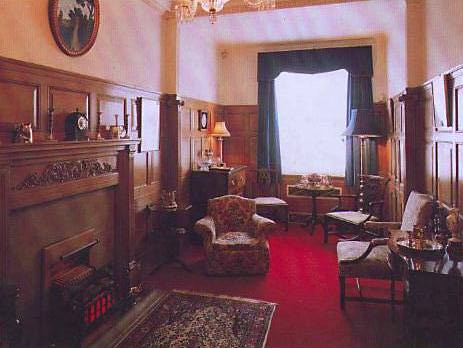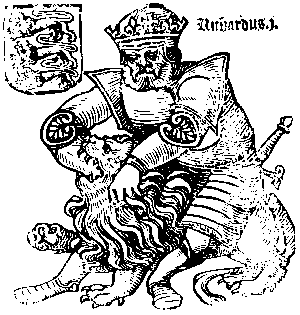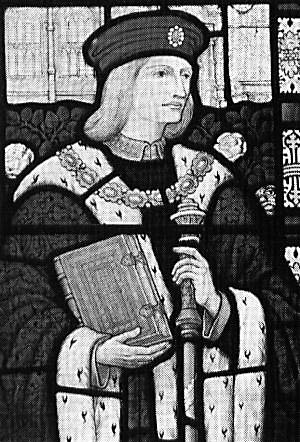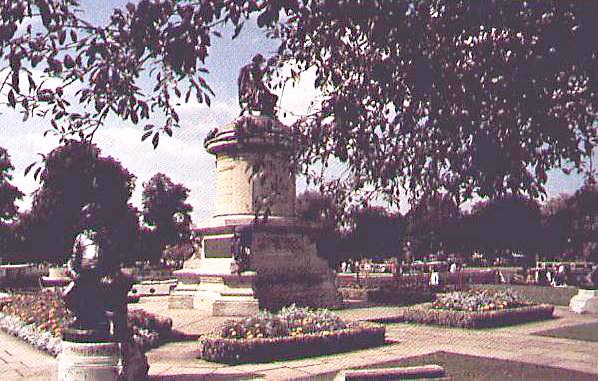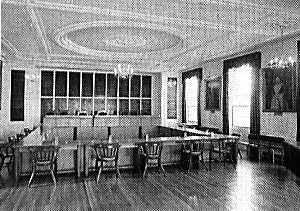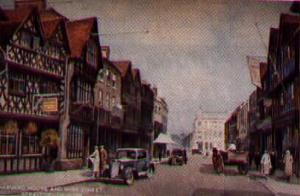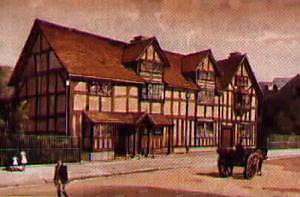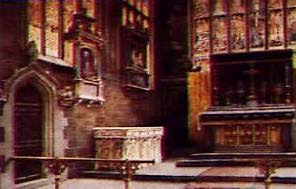STRATFORD-UPON-AVON
| ||||||||||||||||||||||||||||||||||||||||||||||||||||||
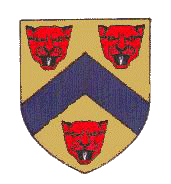
|
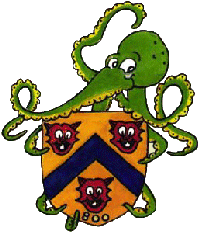
|
FOREWORD - By the two MayorsThe Mayor's Parlour It is a great privilege to be the Mayor of Stratford-upon-Avon, and the more so during the town's 800th Anniversary year. In many ways, Stratford-upon-Avon is a small town.The town extends little more than four miles across in any direction; and the change from town to countryside is immediately apparent. The population is around 22,000. Nevertheless, every year 2½ million people come to Stratford-upon-Avon, one of the most popular places in the United Kingdom after London. Why is this? Undoubtedly it is because William Shakespeare was born here, lived and retired here, and is buried in our own Parish Church. As a playwright he is amongst the world's best. His works are performed and studied internationally. Stratford, however, has many other sons and daughters,who have also contributed to the town's distinctive history with a heritage that reaches out beyond the classical theatre. The heritage encompasses a full range of trade, industry, communications, commerce, learning and leisure pursuits. We who are lucky enough to belong to Stratford-upon-Avon are delighted to share our good treasures with so many visitors. For at the end of the day, Stratford-upon-Avon belongs to us all. It is a part of world culture.
|
||
| Councillor Mrs Joan McFarlane Mayor 1995/96 |
Councillor Charles Bates Mayor 1996/97 |
|
THE STORY BEGINS |
||
| The story begins in 1196.
In that year John de Coutances, the Bishop of Worcester decided that the part of his estates near the "strete ford" where the Roman road from Banbury crossed the River Avon should be reconstituted as a town. He laid out a town plan on a grid system - following the pattern adopted centuries before by the Romans and used again in our own generation by town and country planners, notably at Milton Keynes. Then the Bishop of Worcester gave his tenants the right to rent property and transmit it at death. This was called "burgage" tenure. Each development plot or "burgage" was about one quarter of an acre. The plot holders, called "burgesses", paid one shilling a year rent and were allowed by their overlord, the Bishop, to trade freely. In that same year of 1196 the Bishop obtained a special charter from King Richard I so that
the embryonic town could hold a weekly market and attract merchants from elsewhere to come and
trade.
16th Century woodcut of Richard I overpowering a lion.
From 'The Life and Times of Richard I' |
John de Coutances with the street plan for his new town 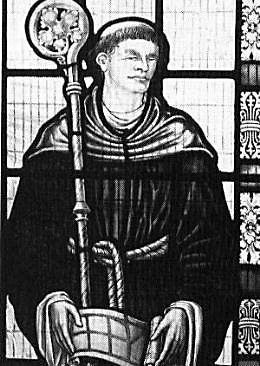
Richard the Lionheart was only too pleased to oblige, as the Royal coffers had been emptied first by his crusades in Palestine, then to raise the ransom money to rescue him from the Duke of Austria, and finally to pay for the war newly started in France. The two charters of 1196 therefore are the twin foundation stones of the Stratford-upon-Avon that we know and love today. |
|
THE STORY CONTINUESOver the years and centuries following the grant of the charters in 1196, Stratford-upon-Avon developed in a distinctive way. In this early history, Stratford-upon-Avon became a town of tradesmen and merchants who established a guild (the Guild of the Holy Cross) to meet their religious and commercial interests. In a sense it was a kind of Rotary which also concerned itself with the welfare of its members and their families. In time the Guild's responsibilities and resources were transferred to the Borough Council and confirmed in King Edward VI's Charter of 1553. The town thus developed its own form of governance, based upon an oligarchy of merchants elected by their contemporaries: in contrast to the villages and farms in the countryside around, which remained part of the landed estates of the Bishop of Worcester and other magnates and were run on hierarchical lines based on inheritance. The Medieval tradesmen in Stratford-upon-Avon valued education just as highly as the local lords of the manor, but their needs were different. Whereas the sons of the noblemen were sent away to other households to learn courtly manners and military skills, tradesman wanted their sons to learn reading and writing locally. Thus in 1427 a pedagogue's house and school were built next to the Guild Chapel and endowed in 1482 by Thomas Jolyffe's benefaction. The school provided free education for Stratford boys whose fathers were members of the Guild of the Holy Cross. Following the Guild's suppression, the school was refounded by the same charter of 1553 and given King Edward VI's name with a requirement to educate "the unripe subjects of His Majesty". Nowadays educational responsibilities for teenagers are shared with the Stratford High School, Stratford Grammar School for Girls and the Stratford College.
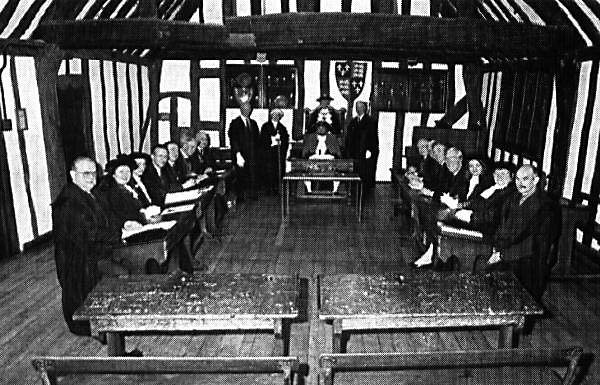 6th February 1996 The Council returns to its earlier meeting place at King Edward VI School
|
Medieval Stratford - The Clopton Story |
||
|---|---|---|
| As well as celebrating Stratford-upon-Avon's 800th Anniversary, 1996 sees the
500th commemoration of the death of Sir Hugh Clopton who died on 15 September 1496. Hugh, a bachelor all his life, made his fortune as a London mercer and gave generously of
his property both here in Stratford, and in London (where he was Lord Mayor in 1492),
Aylesbury and elsewhere.
Sir Hugh Clopton (from The Guild Chapel) |
Holy Trinity Church  In particular:
Hugh Clopton also built New Place at Stratford-upon-Avon - which in the fullness of time was bought by one William Shakespeare as a retirement home. His fine and modest memorial in the Guild Chapel is well worth studying. |
|

Clopton Bridge 1905. |
||
Tudor Stratford - The Shakespeare Story
Baptised in Holy Trinity Church on St George's Day, 23 April 1564, the eldest son of John Shakespeare and Mary Arden, William Shakespeare as a lad went to the newly reformed King Edward VI Free Grammar School at Stratford. In 1582 he married Anne Hathaway of Shottery and then - according to some - left hurriedly for London in 1585, a schoolmaster on the run for poaching deer from the Earl of Warwick's estates nearby. By 1596 - exactly 400 years after the founding of Stratford-upon-Avon - William Shakespeare had become established as a court dramatist and was writing "A Midsummer Night's Dream" and "The Merchant of Venice". In "A Midsummer Night's Dream", he thought back to his tradesman's roots, and ends the drama with Bottom the Weaver and fellow traders getting up a play for the Duke of Athens and local gentry - who are more than a little supercilious about their hamish acting. "The Merchant of Venice" in its own way also draws upon business life: the point at issue is whether a bond to forfeit "a pound of flesh" if three thousand ducats are not repaid by the due date is to be interpreted literally. This same year of 1596 saw William Shakespeare able to obtain a grant of Arms for his father, so that John Shakespeare - variously a Stratfordian glover, butcher and wool dealer, official ale taster and Bailiff (Mayor) - at last became a gentleman. Sadly this year of status and success was also one of sorrow for William and Anne: their only son, Hamnet, died on 11 August 1596 at the age of eleven and a half. Eventually William Shakespeare himself retired back to New Place, Church Street, opposite the Guild Chapel and his old school, and died on the day of his birth, 23 April, in 1616. By 1623, when his wife died, a bust in his memory had been erected near his tomb in Holy Trinity Church - where hundreds of townsfolk and admirers led by The Worshipful the Mayor and Councillors pay floral tribute each April.
|
Eighteenth Century Stratford - The Garrick Story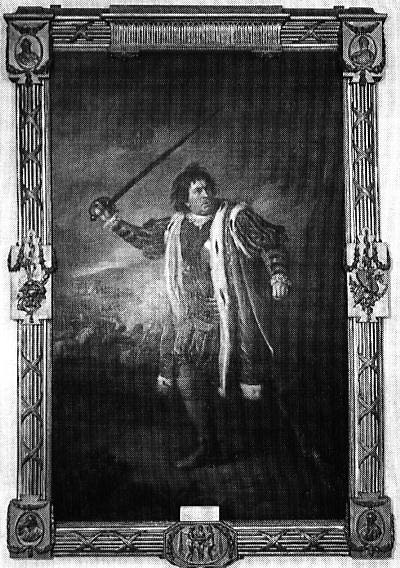
In 1741, David Garrick, then in his 30's, made his reputation as a foremost actor of his day in the title role of Shakespeare's "Richard III". He went on to establish his credentials as the quintessentially Shakespearean interpreter of the classical age of English drama. It is no surprise therefore that for1769 he developed the idea of a Shakespearean Festival here at Stratford-upon-Avon - which continues to this day, over the weekend nearest to Shakespeare's Birthday on 23 April. By more recent tradition these celebrations incorporate the Freedom March by the Corps of Royal Engineers from Long Marston, Beating Retreat, unfurling of nearly 100 flags of the nations of the world particularly associated with Shakespeare and Stratford, and of course the procession by hundreds bearing floral tributes entwined with rosemary for remembrance to the dramatist's tomb beside the High Altar at Holy Trinity Church. When the Town Hall was re-built in 1768, David Garrick himself presented a statue of Shakespeare for the niche on the north side - and in return, the appreciative Mayor and Council elected him the first Freeman of the Borough. The presentational scroll was contained in a small neat chest made from the wood of a mulberry tree planted by William Shakespeare at New Hall over a century before. "David Garrick playing Richard III" from the Town Collection. |
Nineteenth/Early Twentieth Century Stratford - The Flower StorySir Archibold Flower 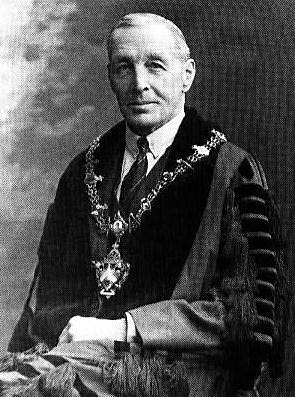 Always a market town and trading centre, Stratford experienced a growth in industrial
activity during the 19th century. The Tramway Bridge, built across the river in 1823 using
local brick, was for an early railway, along which horses pulled wooden carriages carrying coal
and corn between Stratford and Shipston-on-Stour. By 1860 the Great Western Railway had
arrived, and with it the opportunity for day trippers to come from Birmingham, Coventry,
Warwick and many other midland towns and villages (and beyond). They came for the annual
Shakespeare Birthday Weekend, the Regatta, the Mop Fairs, to say nothing of Bank Holidays,
theatre and cinema visits, and family outings on the river.
Always a market town and trading centre, Stratford experienced a growth in industrial
activity during the 19th century. The Tramway Bridge, built across the river in 1823 using
local brick, was for an early railway, along which horses pulled wooden carriages carrying coal
and corn between Stratford and Shipston-on-Stour. By 1860 the Great Western Railway had
arrived, and with it the opportunity for day trippers to come from Birmingham, Coventry,
Warwick and many other midland towns and villages (and beyond). They came for the annual
Shakespeare Birthday Weekend, the Regatta, the Mop Fairs, to say nothing of Bank Holidays,
theatre and cinema visits, and family outings on the river.
During this period the Bancroft, the place where poor townsfolk from the town's earliest days had kept their pigs and poultry, was turned into a waterfront of bustling commercial activity at the cross-roads of river, canal, tramway and Roman road to Banbury. Where the Gower Memorial statue to William Shakespeare holds pride of place now were warehouses, wharves and sheds. A tannery (which smelled horribly in hot weather!) was just upstream of Holy Trinity Church; stonemasons and boat builders practised their craft; and James Cox & Son ran the sawmill and timber yard adjoining Clopton Bridge, using new fangled steam engines. As the 19th century progressed, so the Flower family began to buy up land along the waterfront. The brewery founded in 1833 by Edward Fordham Flower was one of the largest employers in the town, whose interests the family had very much at heart: four generations in turn became Mayor. In the 1870's Charles Flower gave land and £1,000 to launch a fund to build the Shakespeare Memorial Theatre - and as Mayor on Shakespeare's Birthday, 23 April, in the year 1879 had the privilege of opening a beautiful High Victorian playhouse of intricate brickwork and castle features. Shortly afterwards, he initiated measures to transform the Bancroft into a pleasure garden for townsfolk - as it remains to this day. In the 1890's his brother Edgar brought the medieval grammar school buildings back into a proper state of repair and restoration. "Aunt Sarah" continued the philanthropic tradition, caring not only for all of the many nieces and nephews, but also for employees and townsfolk and their children, even to the extent of purchasing numerous grave spaces at the newly opened municipal cemetery in Evesham Road, to lessen the fear of a pauper's burial. Sir Archibald Flower, (Mayor in 1932), maintained the family theatrical involvement, and oversaw the fund-raising for the re-building of the Shakespeare Memorial Theatre, opened that same year.
|
The Story Today - Stratford In BloomThe "Beautiful Britain in Bloom" was an initiative adopted by the Tidy Britain Group soon after the restoration of peace in 1945, as a way of counteracting the widespread devastation of towns and the austerity of the post war years. The Stratford in Bloom Committee was first set up in 1981. The committee comprises local representatives of sectors with a specific interest in the town, such as retailers, manufacturers, hoteliers and restaurants and pub managers. It is independent of both the Town Council and the District Council, although the Mayor is a well received ex-officio member of the committee, and the District Council is also represented.
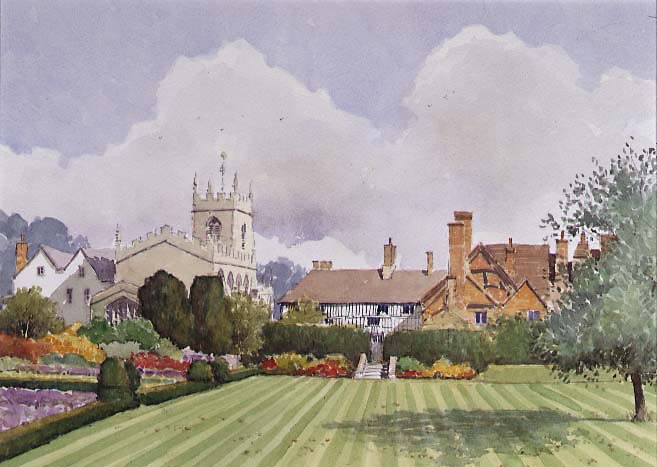
Garden of New Place Thanks to the unstinting efforts of all concerned, Stratford is a habitual winner of the Heart of England contest - even when promoted from the "Small Town" category to the "Town" category, which brought Stratford into competition with some powerful rivals indeed. Competition, however, breeds success, as Stratford reaches the European contests. In celebration of Stratford's 800th birthday in 1996, the theme colours are the Town's colours - blue and yellow with a hint of red. This is reflected also in this year's specially commissioned "Touch and Smell" planting in the water troughs of the American Fountain at Rother Street, in response to a request by some residents with impaired sight.
|
The Story Today - Stratford's Christmas LightsEvery autumn the Christmas Lights Committee takes up with vigour the annual task of ensuring that the illuminated street decorations are "the best in the country" - or rather the world, because visitors come from home and abroad specially to view them. The lights stretch in blazes of glory along and across the five thoroughfares - Bridge Street, High Street, Wood Street, Meer Street and Guild Street - stretching out like a star from the roundabout at Market Cross, itself adorned with a giant, sparkling Christmas Tree. Each street has its own theme and colour scheme: and the magic continues along Greenhill Street, Rother Street and Chapel Street. 
Stratford's Christmas Lights - part of the wonder of Christmas The switching-on ceremony is a major event in the town calendar attended by hundreds of children and parents. By tradition local pupils sing carols, the Vicar reads prayers, and The Worshipful the Mayor in full ceremonial dress moves the switch that illuminates the whole of central Stratford with Christmas splendour in an instant. A week later the civic party re-assembles to join with the Stratford Lions Club and late night shoppers for a carol sing-along in Bridge Street, followed by a bus-top tour of the lights. Everyone is invited back to the Town Hall for coffee and mince pies.
|
800th Birthday And A Year-Long Celebration
|
The Story Today - Swan Hopping(Researched and compiled by Roxanne Bennis) In 1867, the Rev G J Granville, upon retiring from Stratford to go to Pleasley Rectory in Derbyshire, presented his swans to the Stratford Corporation. This seems to have been an informal gift, and circumstances soon led the Corporation to clarify their position. The entry from the Minute Book of the Borough Council, for the Quarterly Meeting on 5 August 1868, reads: "The Treasurer produced a letter from the Rev G J Granville giving over his claim to the Swans on the River Avon to the Corporation…we direct the Treasurer… to take all necessary steps for the futureprotection of the Swans on the Avon which shall be considered the property of the Corporation." The 19th century Borough Council's attitude toward the swans was similar to that of a medieval lord, in that the swans were considered an asset and a status symbol, rather than ordinary wildlife. Swans could be purchased from the Corporation for the price of one guinea per cygnet, the first purchase being made by Mrs Starkey of Rhine Hill in 1868. They were also presented as gifts to other individuals or Town Councils, and over the years, continuing into the 20th century, swans were presented to, amongst others, Lady Trevelyan, Lord Willoughby de Broke, and the boroughs of Glasgow, Bury St Edmunds, and East Ham. It is interesting to note that when swans were presented to other towns, it was always in response to a request from that particular town. Even then there seems to have been a certain mystique surrounding Stratford swans! The Corporation also continued the more prosaic tradition of the swan as a delicacy for the table. Every year two cygnets were caught and prepared for the Mayor's Feast in September/October, where they appeared on the menu alongside tongues, pigeon pies, ducks and geese. In order to maintain their exclusive right to the swans, it was necessary to mark them in some way, and the following year, on 13 August 1869, the Stratford Herald reported an "Interesting Ceremony" - which for almost the next twenty years was to be an annual fixture on the Council calendar. Although the proper term for the procedure is "Swan-Upping", it was consistently referred to locally by the corrupted term "Swan-Hopping". From the almost yearly newspaper articles on the event, it is possible to describe a typical swan-hopping. Every August or September, the swan-hopping party would assemble at Bridgefoot or the Unicorn dock, and would consist
of the Mayor, Borough Chamberlain, various Councillors, Macebearers, the Beadle, Superintendent of Police, Vicar of Holy
Trinity Church, Headmaster of King Edward VI Grammar School, PC Harris (the town's semi-official swan-keeper), and other
gentlemen and ladies of Stratford society. Swan hopping as photographed in 1886 - with the Superintendent of Police in the first boat 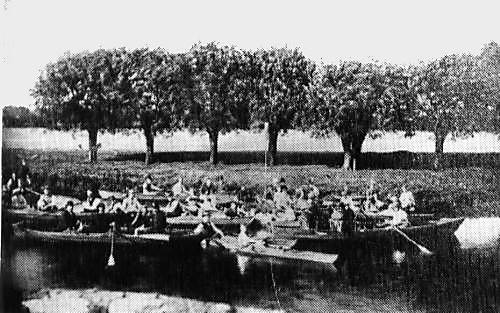
The party would row along the river, starting from Lucy's Mill as far up river as Tiddington, in search of swans. The swans would be corralled in a side creek or between the boats to be caught, or driven up river in advance of the boats to be caught later. Procedures varied - they would be sometimes marked and released on the spot, or transported in boats up river to be marked in a meadow all at one time. This part of the swan-hopping seems to have been a good two to three hours of "messing about in boats", and there are reports of a macebearer and a police officer falling in the river; mention of "a little splashing and sprinkling, of which the ladies, by sheer accident, obtained rather more then their share"; and a report of a worthy Alderman's beaver hat coming to grief by coming into contact with a weeping willow. The method of marking the swans was to use a sharp steel punch to perforate a small hole in the web of the left foot. As this could heal over, it was necessary to catch all the birds each year to see if re-marking was needed. The perforating was done by the Beadle one year, and another time the Mayor marked the first swan. The birds were also pinioned, to ensure their remaining in Stratford. Afterwards there was a picnic on the riverbank of bread, cheese and onion, with beer or whiskey for the men, and sherry for the ladies. This was followed by a leisurely row downstream to Stratford. Although no definite numbers are given, there seems to have been ten to twenty swans on the river at this time. Throughout the 1870's Stratford Corporation was very proud of its swans and its swan-hopping, with newspaper articles referring to time-honoured customs and ancient ceremonies remaining as a local institution, and at pains to point out that the Stratford Corporation was one of only a few bodies with the privilege of marking their own birds. However, interest diminished gradually through the 1880's, until by 1891 the old custom of swan-hopping was described as having fallen into disuse. Note: This ceremony was revived on the 18th May 1996 for the 800th Anniversary celebrations.
|
The Story Today - Cattle And Street MarketsAs befits an historic market town, Stratford-upon-Avon is home to the cattle market now run by Sheldon Bosley every Tuesday on the traditional site near the railway station. Associated with the cattle market are four events, which are major dates in the local agricultural calendar, and especially so in this commemorative year:
|
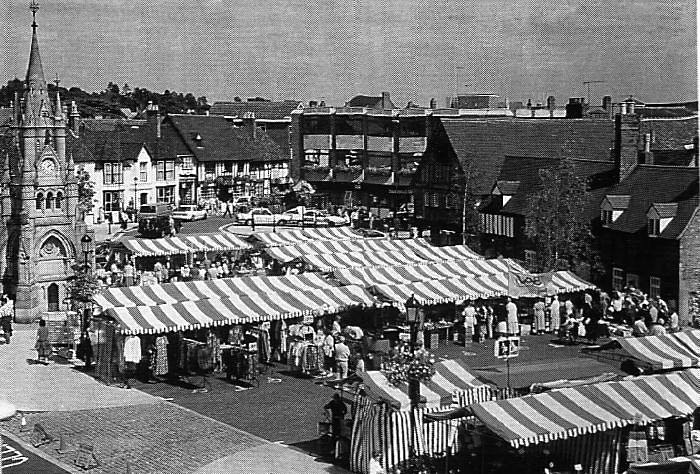
Rother Street Market |
The marketing tradition of Stratford-upon-Avon is continued every week by a Friday street market in Rother Street - the very name means "oxon". Here the thrifty housewife can buy fruit and vegetables, meat and fish, clothes and household goods whilst the less restrained can find jewellery, fancy goods and objects d'art. Space is always kept for a charity stall. The market operators on behalf of the Town Council - E G Skett & Co - are themselves an old established firm, and gave the pavement mosaics around the American Fountain at the head of Rother Street 1994. The six panels depict the various roles that Rother Street has played throughout the centuries - eg, in medieval times it was the place for selling crucial items as selling malt, salt and vegetables. On Friday 5 July the street market returns to its original site in Bridge Street for a Commemoration Special involving medieval dress, additional displays, and a pig roast.
|
The Story Today - 800 Years Of Town And Church(With contribution by Revd Jean Fletcher on behalf of the Council of Churches)The Stratford Council of Churches is a living testimony to present collaboration after a long and sometimes turbulent history. Christian witness goes back a very long way. We can reflect on the history of faith right from the time of Abraham. Christianity was brought to our land by Celtic and Roman missionaries nearly 800 years before Stratford was founded; and Stratford stands very much in the midst of all this activity, not least geographically. Stratford's "parent" was the Church. Where the road crossed the river, a thousand years ago the Church owned lands.
Later the Church built the social and spiritual life of the town. Two of its sons, John and Robert de Stratforde, uncle and
nephew, became Archbishops of Canterbury in the Middle Ages.
The Church founded and controlled the Guild of the Holy Cross which regulated community, civic and religious life of the town, looked after the sick, taught the young, housed the aged, prayed for the dead, and collected wealth and property - until dissolved in 1547. This created a vacuum in the provision of welfare until Edward VI was prevailed upon to transfer the Guild Estates to the town's council, to be used for much the same benevolent purposes. Later the Non-conformist denominations arose, and there was a blossoming of new churches in Stratford during
Victorian times. Holy Trinity Church Nowadays there are 15 member congregations of the Council of Churches, drawn from the Anglican, Roman Catholic, Methodist, United Reformed, Baptist, Society of Friends (Quakers), Salvation Army, and Independent denominations. Each of these churches is appreciated for their special insights and traditions which together make up a rich tapestry indeed. In this special year of celebration they join in offering places of praise and prayer for everyone.
|
The Story Today - Stratford MopsFor centuries Stratford-upon-Avon was the place for a hiring fair, to which farmers, tradesmen and householders came to meet and engage their servants for the coming year. It was customary for those wishing to be hired to indicate their trade e.g. carters and waggoners wore a piece of whipcord twisted round their hats, thatchers a fragment of woven straw and shepherds held their sheep-crooks - see Thomas Hardy's evocation in "Far from the Madding Crowd". After the First World War, the Stratford-upon-Avon Mop - always held on the 12 October - became a funfair with side shows, rides and roundabouts. Pig roasts and ox roasts were customary outside public houses, as the landlords' contribution to the festivities. Charity stalls also had a part - in 1921 for example, Miss Annie Davis' Navy League stall made £4 4s 6d. The custom continues to this day, with the Stratford Mop being amongst the biggest, brightest and busiest in the Midlands, occupying the lengths of Bridge Street, High Street, Wood Street, Rother Street, Greenhill Street and Meer Street. A special tradition is that after The Worshipful the Mayor has read the customary Proclamation at Market Cross, the Master of the Mop escorts the civic party on an inspection of the fair - and on whatsoever ride The Worshipful the Mayor goes (attended, of course, by the Beadle, Macebearers and Town Clerk in full ceremonial dress), all children from the town may go free of charge for that one morning. Little wonder that the words of the Proclamation include: We do enjoin all whether ye be townspeople of the town or strangers from other parts and places, that your behaviour be seemly at all times and in all respects, that ye bear goodwill towards one another and ill will towards none, that ye spend this day of merry-making and frolic so that recollections on the morrow may be without regrets or repinings. And, we do further ordain that on this day ye shall have full liberty and licence so desiring to remain in the fair until the stroke of midnight , whereupon at that time, and no later, we do strictly enjoin you quietly and peaceably to return unto your dwellings, having proper regard to the comfort and happiness of friends and neighbours who may then be within their abodes. On the Friday week following the Mop comes traditionally the Runaway Mop, a smaller version of the original hiring fair at which those who were ill-suited to their new employment could seek another master. In this celebratory year of 1996 the Master of the Mop and his Lady, William and Emily Wilson, promise "the best ever". Come and join the fun!
|
Special Stratford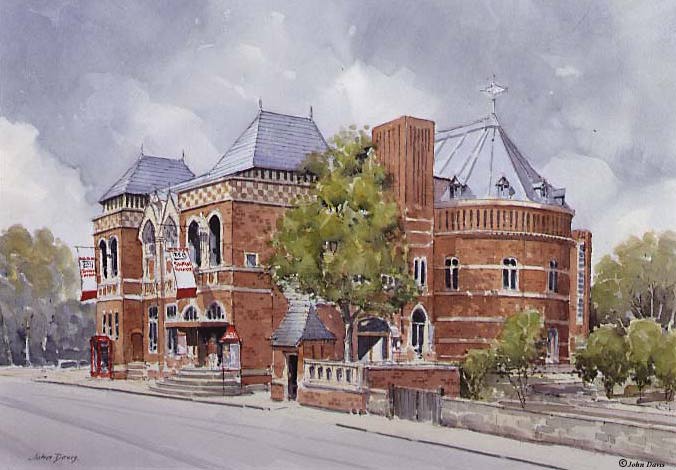
R.S.C. - Swan Theatre & Library Long standing residents of Stratford-upon-Avon whose families go back over the centuries, newcomers, and visitors all agree - Stratford-upon-Avon is special. Why? For three reasons:
Yet Stratford-upon-Avon does not have a motto to accompany its coat of arms, and which could have been used to conclude this booklet commemorating the town's 800th birthday! The reader is at liberty to devise his own!
|
STRATFORD-UPON-AVON
|
L'Envoi - A Community Celebrates
| |||||||||
To contact Quinsolve see our web pages on http://www.quinsolve.co.uk
Note: This information was correct at the time of preparation, however QuinSolve accepts no responsibility for discrepancies or omissions.
